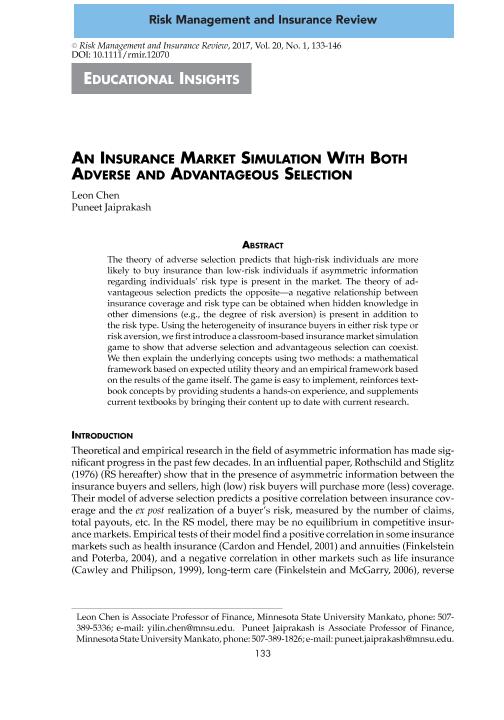An Insurance market simulation with both adverse and advantageous selection

Contenido multimedia no disponible por derechos de autor o por acceso restringido. Contacte con la institución para más información.
| Tag | 1 | 2 | Value |
|---|---|---|---|
| LDR | 00000cab a2200000 4500 | ||
| 001 | MAP20170012542 | ||
| 003 | MAP | ||
| 005 | 20170426130211.0 | ||
| 008 | 170417e20170301esp|||p |0|||b|spa d | ||
| 040 | $aMAP$bspa$dMAP | ||
| 084 | $a7 | ||
| 100 | $0MAPA20150013958$aChen, Leon | ||
| 245 | 1 | 3 | $aAn Insurance market simulation with both adverse and advantageous selection$cLeon Chen and Puneet Jaiprakash |
| 520 | $aThe theory of adverse selection predicts that high-risk individuals are more likely to buy insurance than low-risk individuals if asymmetric information regarding individuals¿ risk type is present in the market. The theory of advantageous selection predicts the oppositea negative relationship between insurance coverage and risk type can be obtained when hidden knowledge in other dimensions (e.g., the degree of risk aversion) is present in addition to the risk type. Using the heterogeneity of insurance buyers in either risk type or risk aversion, we first introduce a classroom-based insurance market simulation game to show that adverse selection and advantageous selection can coexist. We then explain the underlying concepts using two methods: a mathematical framework based on expected utility theory and an empirical framework based on the results of the game itself. The game is easy to implement, reinforces textbook concepts by providing students a hands-on experience, and supplements current textbooks by bringing their content up to date with current research. | ||
| 650 | 4 | $0MAPA20080591182$aGerencia de riesgos | |
| 650 | 4 | $0MAPA20120015227$aComparadores de seguros | |
| 650 | 4 | $0MAPA20080586294$aMercado de seguros | |
| 773 | 0 | $wMAP20077001748$tRisk management & insurance review$dMalden, MA : The American Risk and Insurance Association by Blackwell Publishing, 1999-$x1098-1616$g01/03/2017 Tomo 20 Número 1 - 2017 , p. 133-146 |

